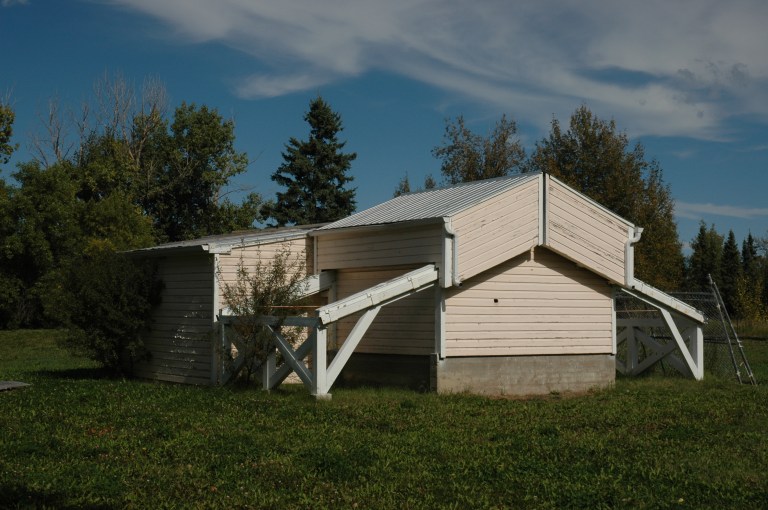Among the fundamentalist groups from eastern Europe to seek a haven in western Canada in the early 20th century were the Doukhobors. Unlike most others, such as Mennonites and Hutterites, the Doukhobors were culturally Russian and dissenters from the Orthodox faith. Feeling persecuted under the regime of Tsar Nicholas II, about 7,400 of them sailed to Canada in the spring of 1898-99. Most moved on to Saskatchewan, where they were joined by their spiritual leader, Peter Verigin in 1902. Here, they were granted exemption from military service and allowed to educate their children in their own schools. They sought to obtain homesteads near Yorkton, but, since gaining title to homestead land meant signing an oath of loyalty to the British (and Canadian) Crown, many abandoned their incipient farms and moved on to the southern interior of British Columbia, where, in 1908, Verigin was able to purchase, on their behalf, sizeable tracts of land at Brilliant (near Castlegar) and near Grand Forks in the Kootnay district, just north of the Washington State border. The colonies eventually included about 6,000 members. They called themselves the Christian Community of the Universal Brotherhood.
 Because the colonies became so heavily populated, Verigin undertook to found other smaller colonies. One of these was begun in 1915 in the Cowley-Lundbreck district of southern Alberta, and initially included about 50 people. It was headed by Semeon Ivanovitch Verigin. Here, individual quarter-sections were purchased in relative proximity to each other. The spread-out colony was called “Bogatoi Rodnik,” or “Rich Spring,” and eventually totaled 13,500 acres with around 300 people. It became divided into 13 units, which featured grain elevators, flour mills, blacksmith shops and other buildings, including prayer homes. As a fundamentalist group, these people eschewed formalized churches. There was one dwelling at Cowley reserved for Peter “The Lordly” Verigin, for, although usually absent, he remained the spiritual and administrative leader of the colony, with each small commune within the colony electing its own local leader.
Because the colonies became so heavily populated, Verigin undertook to found other smaller colonies. One of these was begun in 1915 in the Cowley-Lundbreck district of southern Alberta, and initially included about 50 people. It was headed by Semeon Ivanovitch Verigin. Here, individual quarter-sections were purchased in relative proximity to each other. The spread-out colony was called “Bogatoi Rodnik,” or “Rich Spring,” and eventually totaled 13,500 acres with around 300 people. It became divided into 13 units, which featured grain elevators, flour mills, blacksmith shops and other buildings, including prayer homes. As a fundamentalist group, these people eschewed formalized churches. There was one dwelling at Cowley reserved for Peter “The Lordly” Verigin, for, although usually absent, he remained the spiritual and administrative leader of the colony, with each small commune within the colony electing its own local leader.
One of the purposes of this colony was to supply flour and other grain products to the BC colonies which had become too heavily populated within their geographic parameters to sustain themselves agriculturally, with much of the hilly land there given over to ranching, fruit growing and lumbering. Besides, being vegetarians, the Doukhobors required more than the normal amount of non-meat produce. As the Cowley-Lundbreck Colony was located on the southern branch of the CPR, it was easier, and cheaper, to ship produce from there to Brilliant and Grand Forks than from the larger prairie colony of Verigin near Yorkton, Saskatchewan. In return for the produce, fruit and lumber were sent from the BC colonies to Bogatoi Rodnik.
In 1924, Peter the Lordly Verigin was assassinated by a time-bomb which exploded in a train near Grande Forks, killing nine other passengers as well. His son, Peter Petrovitch Verigin, who was living in Russia, was sent for to assume the position of leader. However, another charismatic figure in Brilliant, Anastasia Holoboff, known as Anastasia Lords, a “close companion of the late leader,” let it be known that she had been specially tutored by Peter the Lordly to be his successor. A rift then formed within the community. Most Doukhobors, including those around Cowley and Lundreck, accepted Peter Petrovitch, but, in 1926, a group under Anastasia broke away and formed a new colony in the district of Shouldice, Alberta.
Due to financial straits and the loss of young people to mainstream society, the colony around Lundbreck continued to decline in the 1930s and 1940s. Those who stayed began to work as private farmers. In 1953, they erected a central prayer home which remains standing as a symbol of the Doukhobor faith as it persisted in southern Alberta during the mid and latter 20th century. In March 2010, the Hall was designated a Provincial Historic Resource.
Written by: David Leonard, Historian
Visit the Alberta Register of Historic Places to learn more about the heritage value of the Doukhobor Prayer Home in Lundbreck. In order for a site to be designated a Provincial Historic Resource, it must possess province-wide significance. To properly assess the historic importance of a resource, a historian crafts a context document that situates a resource within its time and place and compares it to similar resources in other parts of the province. This allows staff to determine the importance of a resource to a particular theme, time, and place. Above, is some of the historical information used in the evaluation of the Doukhobor Prayer Home.





 Not quite. For a place to be listed on the
Not quite. For a place to be listed on the 





